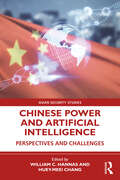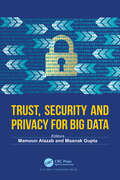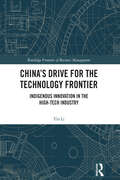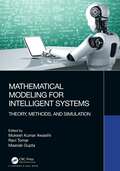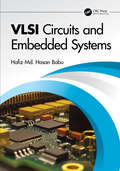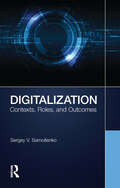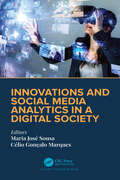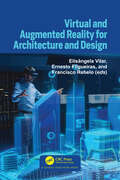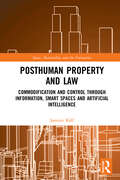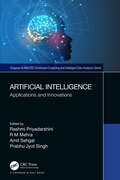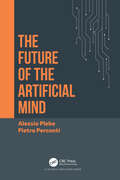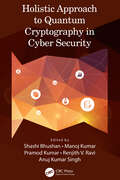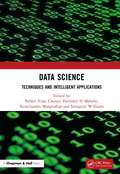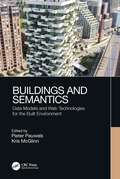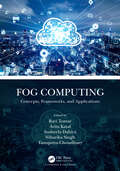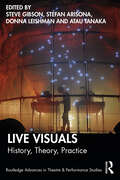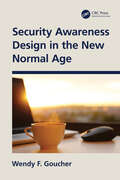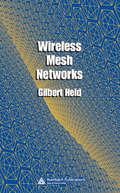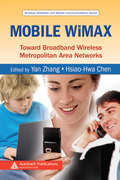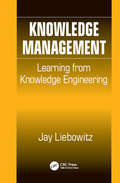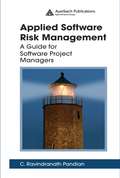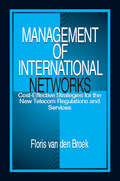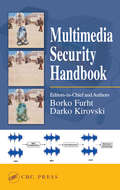- Table View
- List View
Chinese Power and Artificial Intelligence: Perspectives and Challenges (Asian Security Studies)
by William C. HannasThis book provides a comprehensive account of Chinese AI in its various facets, based on primary Chinese-language sources. China’s rise as an AI power is an event of importance to the world and a potential challenge to liberal democracies. Filling a gap in the literature, this volume is fully documented, data-driven, and presented in a scholarly format suitable for citation and for supporting downstream research, while also remaining accessible to laypersons. It brings together 15 recognized international experts to present a full treatment of Chinese artificial intelligence. The volume contains chapters on state, commercial, and foreign sources of China’s AI power; China’s AI talent, scholarship, and global standing; the impact of AI on China’s development of cutting-edge disciplines; China’s use of AI in military, cyber, and surveillance applications; AI safety, threat mitigation, and the technology’s likely trajectory. The book ends with recommendations drawn from the authors’ interactions with policymakers and specialists worldwide, aimed at encouraging AI’s healthy development in China and preparing the rest of the world to engage with it. This book will be of much interest to students of Chinese politics, science and technology studies, security studies and international relations.
Trust, Security and Privacy for Big Data
by Mamoun AlazabData has revolutionized the digital ecosystem. Readily available large datasets foster AI and machine learning automated solutions. The data generated from diverse and varied sources including IoT, social platforms, healthcare, system logs, bio-informatics, etc. contribute to and define the ethos of Big Data which is volume, velocity and variety. Data lakes formed by the amalgamation of data from these sources requires powerful, scalable and resilient storage and processing platforms to reveal the true value hidden inside this data mine. Data formats and its collection from various sources not only introduce unprecedented challenges to different domains including IoT, manufacturing, smart cars, power grids etc., but also highlight the security and privacy issues in this age of big data. Security and privacy in big data is facing many challenges, such as generative adversary networks, efficient encryption and decryption algorithms, encrypted information retrieval, attribute-based encryption, attacks on availability, and reliability. Providing security and privacy for big data storage, transmission, and processing have been attracting much attention in all big data related areas.The book provides timely and comprehensive information for researchers and industry partners in communications and networking domains to review the latest results in security and privacy related work of Big Data. It will serve computer science and cybersecurity communities including researchers, academicians, students, and practitioners who have interest in big data trust privacy and security aspects. It is a comprehensive work on the most recent developments in security of datasets from varied sources including IoT, cyber physical domains, big data architectures, studies for trustworthy computing, and approaches for distributed systems and big data security solutions etc.
Data Science for Effective Healthcare Systems (Chapman & Hall/CRC Internet of Things)
by Hari Singh Ravindara Bhatt Prateek Thakral Dinesh Chander VermaData Science for Effective Healthcare Systems has a prime focus on the importance of data science in the healthcare domain. Various applications of data science in the health care domain have been studied to find possible solutions. In this period of COVID-19 pandemic data science and allied areas plays a vital role to deal with various aspect of health care. Image processing, detection & prevention from COVID-19 virus, drug discovery, early prediction, and prevention of diseases are some thrust areas where data science has proven to be indispensable. Key Features: The book offers comprehensive coverage of the most essential topics, including: Big Data Analytics, Applications & Challenges in Healthcare Descriptive, Predictive and Prescriptive Analytics in Healthcare Artificial Intelligence, Machine Learning, Deep Learning and IoT in Healthcare Data Science in Covid-19, Diabetes, Coronary Heart Diseases, Breast Cancer, Brain Tumor The aim of this book is also to provide the future scope of these technologies in the health care domain. Last but not the least, this book will surely benefit research scholar, persons associated with healthcare, faculty, research organizations, and students to get insights into these emerging technologies in the healthcare domain.
China’s Drive for the Technology Frontier: Indigenous Innovation in the High-Tech Industry (Routledge Frontiers of Business Management)
by Yin LiChina has become an innovation powerhouse in high-tech industries, but the widely held view assumes the Chinese model is built on technological borrowing and state capitalism. This book debunks the myths surrounding the Chinese model with a fresh take on China’s strategies for technological innovation. The central argument is that indigenous innovation plays a critical role in transforming the Chinese high-tech industry. Like any successfully industrialized nation in history, indigenous innovation in China allows industrial enterprises to assimilate knowledge developed elsewhere, utilize science and technology resources and human capabilities accumulated in the country, and eventually approach the technological frontier. The question is, how do Chinese businesses and governments engage in indigenous innovation? Employing the "social conditions of innovative enterprise" framework developed by William Lazonick and colleagues, this book analyzes how the interaction of strategy, organization, and finance in leading Chinese high-tech firms underpinned by national institutions enables indigenous innovation with Chinese characteristics. It features detailed case studies of two critical high-tech industries—the telecom-equipment industry and the semiconductor industry—and within them, the business histories of leading Chinese innovators. The in-depth look into China’s experience in indigenous innovation provides valuable lessons for advanced and emerging economies.
Mathematical Modeling for Intelligent Systems: Theory, Methods, and Simulation
by Mukesh Kumar AwasthiMathematical Modeling for Intelligent Systems: Theory, Methods, and Simulation aims to provide a reference for the applications of mathematical modeling using intelligent techniques in various unique industry problems in the era of Industry 4.0. Providing a thorough introduction to the field of soft-computing techniques, this book covers every major technique in artificial intelligence in a clear and practical style. It also highlights current research and applications, addresses issues encountered in the development of applied systems, and describes a wide range of intelligent systems techniques, including neural networks, fuzzy logic, evolutionary strategy, and genetic algorithms. This book demonstrates concepts through simulation examples and practical experimental results. Key Features: • Offers a well-balanced mathematical analysis of modeling physical systems • Summarizes basic principles in differential geometry and convex analysis as needed • Covers a wide range of industrial and social applications and bridges the gap between core theory and costly experiments through simulations and modeling • Focuses on manifold ranging from stability of fluid flows, nanofluids, drug delivery, and security of image data to pandemic modeling, etc. This book is primarily aimed at advanced undergraduates and postgraduate students studying computer science, mathematics, and statistics. Researchers and professionals will also find this book useful.
Advancing Computational Intelligence Techniques for Security Systems Design (Computational Intelligence Techniques)
by Uzzal Sharma, Parmanand Astya, Anupam Baliyan, Salah-ddine Krit, Vishal Jain and Mohammad Zubair KhanSecurity systems have become an integral part of the building and large complex setups, and intervention of the computational intelligence (CI) paradigm plays an important role in security system architecture. This book covers both theoretical contributions and practical applications in security system design by applying the Internet of Things (IoT) and CI. It further explains the application of IoT in the design of modern security systems and how IoT blended with computational intel- ligence can make any security system improved and realizable. Key features: Focuses on the computational intelligence techniques of security system design Covers applications and algorithms of discussed computational intelligence techniques Includes convergence-based and enterprise integrated security systems with their applications Explains emerging laws, policies, and tools affecting the landscape of cyber security Discusses application of sensors toward the design of security systems This book will be useful for graduate students and researchers in electrical, computer engineering, security system design and engineering.
VLSI Circuits and Embedded Systems
by Hafiz Md. BabuVery Large-Scale Integration (VLSI) creates an integrated circuit (IC) by combining thousands of transistors into a single chip. While designing a circuit, reduction of power consumption is a great challenge. VLSI designs reduce the size of circuits which eventually reduces the power consumption of the devices. However, it increases the complexity of the digital system. Therefore, computer-aided design tools are introduced into hardware design processes. Unlike the general-purpose computer, an embedded system is engineered to manage a wide range of processing tasks. Single or multiple processing cores manage embedded systems in the form of microcontrollers, digital signal processors, field-programmable gate arrays, and application-specific integrated circuits. Security threats have become a significant issue since most embedded systems lack security even more than personal computers. Many embedded systems hacking tools are readily available on the internet. Hacking in the PDAs and modems is a pervasive example of embedded systems hacking. This book explores the designs of VLSI circuits and embedded systems. These two vast topics are divided into four parts. In the book's first part, the Decision Diagrams (DD) have been covered. DDs have extensively used Computer-Aided Design (CAD) software to synthesize circuits and formal verification. The book's second part mainly covers the design architectures of Multiple-Valued Logic (MVL) Circuits. MVL circuits offer several potential opportunities to improve present VLSI circuit designs. The book's third part deals with Programmable Logic Devices (PLD). PLDs can be programmed to incorporate a complex logic function within a single IC for VLSI circuits and Embedded Systems. The fourth part of the book concentrates on the design architectures of Complex Digital Circuits of Embedded Systems. As a whole, from this book, core researchers, academicians, and students will get the complete picture of VLSI Circuits and Embedded Systems and their applications.
Digitalization: Contexts, Roles, and Outcomes
by Sergey V. SamoilenkoConceptually, as well as practically, digitalization is similar to the implementation of a modern computation model – the model may be a centralized setup using a mainframe or it may be extended to an N-tier architecture. Regardless of the specifics of the implementation, however, the conceptual model of data processing remains the same. Digitalization is nothing but a system relying on digital technologies to create, conduct and, potentially, expand a business activity of some sort. Digitalization can be used to create an e-commerce model for a small business or to create a global supply and distribution chain geared toward almost any kind of a business. It could also be used for non-profit purposes, such as on-line education and telemedicine or e-government. Digitalization: Contexts, Roles, and Outcomes is a contemplation and analysis of the socio-technical system that is known as digitalization. It considers the context of digitalization as well as the ways by which digitalization offers value to the context within which it operates. This book aims to offer readers an entry point to a path of inquiry into the different aspects of digitalization. The goal is to identify main directions for further inquiry as well as to outline the most obvious obstacles along the way. The book aims to guide readers on their own unique journeys using the basic ideas, principles, and concepts synthesized, developed, and presented in the book. It is beneficial to both practitioners and researchers. The book covers: The functionality of digitalization The significance of digitalization Identifying the context of digitalization Designing a control system A cognitive model for the theory of digitalization Designing a theory of digitalization The book helps readers to consider the subject of digitalization in a rigorous and rational way so their own perspectives can emerge stronger and be substantiated and reinforced by building an argument vis-à-vis perspectives and points examined in this book.
Innovations and Social Media Analytics in a Digital Society
by Maria José Sousa and Célio Gonçalo MarquesRecent advances in digitization are transforming healthcare, education, tourism, information technology, and some other sectors. Social media analytics are tools that can be used to measure innovation and the relation of the companies with the citizens. This book comprises state-ofthe-art social media analytics, and advanced innovation policies in the digitization of society. The number of applications that can be used to create and analyze social media analytics generates large amounts of data called big data, including measures of the use of the technologies to develop or to use new services to improve the quality of life of the citizens. Digitization has applications in fields from remote monitoring to smart sensors and other devices. Integration generates data that need to be analyzed and visualized in an easy and clear way, that will be some of the proposals of the researchers present in this book. This volume offers valuable insights to researchers on how to design innovative digital analytics systems and how to improve information delivery remotely.
Virtual and Augmented Reality for Architecture and Design
by Elisângela Vilar, Ernesto Filgueiras and Francisco RebeloVirtual Reality (VR) is the paradigm wherein people use a computer to interact with something which is not real but provides a real-life experience. It is one of the most advanced interfaces between users and computers, where people can interact with a virtual model in real-time allowing them to visualize and manipulate representations of the real world. Together with Augmented Reality (AR), which adds layers of information to the real environment, VR is a powerful tool for designers and architects in the development of new responsive products, systems and built environments, that meets user's needs. VR and AR are tools that enhance design and architecture students' comprehension about complex and abstract concepts. Informative and accessible, this publication presents, analyses, and discusses the integration and use of Virtual and Augmented Reality within the process of planning, development and research for Design and Architecture. The book also presents case studies with multidisciplinary collaborative work. This book is meant for practitioners and academics alike, as it examines specific aspects related to the use of new technologies in the field of Architecture and Design, highlighting its application in areas such as education, heritage, research, and methodologies, bridging the gap between Architectural and Design abstraction and human requirements through technology.
Posthuman Property and Law: Commodification and Control through Information, Smart Spaces and Artificial Intelligence
by Jannice KällThis book analyses the phenomenon of digitally mediated property and considers how it problematises the boundary between human and nonhuman actors. The book addresses the increasingly porous border between personhood and property in digitized settings and considers how the increased commodification of knowledge makes visible a rupture in the liberal concept of the property owning, free, person. Engaging with the latest work in posthumanist and new materialist theory, it shows, how property as a concept as well as a means for control, changes fundamentally under advanced capitalism. Such change is exemplified by the way in which data, as an object of commodification, is extracted from human activities yet is also directly used to affectively control – or nudge – humans. Taking up a range of human engagements with digital platforms and coded architectures, as well as the circulation of affects through practices of artificial intelligence that are employed to shape behaviour, the book argues that property now needs to be understood according to an ecology of human as well as nonhuman actors. The idea of posthuman property, then, offers both a means to critique property control through digital technologies, as well as to move beyond the notion of the self-owning, object-owning, human. Engaging the most challenging contemporary technological developments, this book will appeal to researchers in the areas of Law and Technology, Legal Theory, Intellectual Property Law, Legal Philosophy, Sociology of Law, Sociology, and Media Studies.
Artificial Intelligence: Applications and Innovations (Chapman & Hall/Distributed Computing and Intelligent Data Analytics Series)
by Rashmi Priyadarshini, R M Mehra, Amit Sehgal and Prabhu Jyot SinghArtificial Intelligence: Applications and Innovations is a book about the science of artificial intelligence (AI). AI is the study of the design of intelligent computational agents. This book provides a valuable resource for researchers, scientists, professionals, academicians and students dealing with the new challenges and advances in the areas of AI and innovations. This book also covers a wide range of applications of machine learning such as fire detection, structural health and pollution monitoring and control. Key Features Provides insight into prospective research and application areas related to industry and technology Discusses industry- based inputs on success stories of technology adoption Discusses technology applications from a research perspective in the field of AI Provides a hands- on approach and case studies for readers of the book to practice and assimilate learning This book is primarily aimed at graduates and post- graduates in computer science, information technology, civil engineering, electronics and electrical engineering and management.
The Future of the Artificial Mind
by Pietro Perconti Alessio PlebeThe Future of the Artificial Mind is about the social and technological challenges posed by the new wave of artificial intelligence, both from a technical and a cognitive perspective. Deep neural networks have brought about tremendous technological improvements. This renaissance in artificial intelligence, after decades of stagnation, has enabled new technologies capable of surpassing human performance, as in the case of visual recognition. The book reviews the key ideas that have enabled these goals to be achieved and their historical origins. The book also considers some of the ethical and social challenges that the future development of artificial intelligence will face. Will humans fall in love with future android dolls? What will artificial sex be like? And what will it be like to travel in cars that will treat us as passengers instead of drivers? But predicting the future appears more magic than science. But when it comes to artificial intelligence, it is a constant temptation. Since it is well known that "the only way to get rid of a temptation is to enjoy it!", the hypothesis considered in the last chapter is that emerging trends point to a near future in which intelligence will be ubiquitous, but it will be difficult to identify its bearer. We may be heading towards an era of widespread intelligence, but an intelligence without accountability.
Holistic Approach to Quantum Cryptography in Cyber Security
by Shashi Bhushan, Manoj Kumar, Pramod Kumar, Renjith V. Ravi and Anuj Kumar SinghThis new book discusses the concepts while also highlighting the challenges in the field of quantum cryptography and also covering cryptographic techniques and cyber security techniques, in a single volume. It comprehensively covers important topics in the field of quantum cryptography with applications, including quantum key distribution, position-based quantum cryptography, quantum teleportation, quantum e-commerce, quantum cloning, cyber security techniques’ architectures and design, cyber security techniques management, software-defined networks, and cyber security techniques for 5G communication. The text also discusses the security of practical quantum key distribution systems, applications and algorithms developed for quantum cryptography, as well as cyber security through quantum computing and quantum cryptography. The text will be beneficial for graduate students, academic researchers, and professionals working in the fields of electrical engineering, electronics and communications engineering, computer science, and information technology.
Data Science: Techniques and Intelligent Applications
by Idongesit Williams Ramchandra Mangrulkar Parikshit N Mahalle Pallavi ChavanThis book covers the topic of data science in a comprehensive manner and synthesizes both fundamental and advanced topics of a research area that has now reached its maturity. The book starts with the basic concepts of data science. It highlights the types of data and their use and importance, followed by a discussion on a wide range of applications of data science and widely used techniques in data science. Key Features • Provides an internationally respected collection of scientific research methods, technologies and applications in the area of data science. • Presents predictive outcomes by applying data science techniques to real-life applications. • Provides readers with the tools, techniques and cases required to excel with modern artificial intelligence methods. • Gives the reader a variety of intelligent applications that can be designed using data science and its allied fields. The book is aimed primarily at advanced undergraduates and graduates studying machine learning and data science. Researchers and professionals will also find this book useful.
Buildings and Semantics: Data Models and Web Technologies for the Built Environment
by Pieter PauwelsThe built environment has been digitizing rapidly and is now transforming into a physical world that is at all times supplemented by a fully web-supported and interconnected digital version, often referred to as Digital Twin. This book shows how diverse data models and web technologies can be created and used for the built environment. Key features of this book are its technical nature and technical detail. The first part of the book highlights a large diversity of IT techniques and their use in the AEC domain, from JSON to XML to EXPRESS to RDF/OWL, for modelling geometry, products, properties, sensor and energy data. The second part of the book focuses on diverse software solutions and approaches, including digital twins, federated data storage on the web, IoT, cloud computing, and smart cities. Key research and strategic development opportunities are comprehensively discussed for distributed web-based building data management, IoT integration and cloud computing. This book aims to serve as a guide and reference for experts and professionals in AEC computing and digital construction including Master's students, PhD researchers, and junior to senior IT-oriented AEC professionals.
Fog Computing: Concepts, Frameworks, and Applications
by Tanupriya Choudhury Ravi Tomar Avita Katal Susheela Dahiya Niharika SinghFog Computing: Concepts, Frameworks, and Applications is arranged in such a way that readers with no prior experience in Fog Computing may explore this domain. It is an accessible source of information for distributed computing researchers as well as professionals looking to improve their security and connectivity understanding in Internet of Things (IoT) devices. This book is also useful for researchers and professionals working in the field of wireless communication security and privacy research. This book is intended for students, professionals, researchers, and developers who are working in or interested in the field of Fog Computing. One of the book's distinguishing aspects is that it covers a variety of case studies and future possibilities in the field of Fog Computing. This book: Begins by covering the fundamental notions of Fog Computing to help readers grasp the technology, starting from the basics Explains Fog Computing architecture as well as the convergence of Fog, IoT, and Cloud Computing Provides an assessment of Fog Computing and its applications in the field of IoT Discusses the usage of software defined networking and machine learning algorithms as they apply to Fog Computing Describes the different security and privacy issues with Fog Computing and explores single point control systems for consumer devices using Edge-Fog Computing Outlines in detail how to leverage Blockchain technology in Fog Computing, as well as how to use Fog Computing in telemedicine and healthcare applications Examines the usage of communication protocols, simulation tools for Fog Computing implementation, and case studies in the fields of bioinformatics, disaster control, and IoT
Live Visuals: History, Theory, Practice (Routledge Advances in Theatre & Performance Studies)
by Steve Gibson Stefan Arisona Donna Leishman Atau TanakaThis volume surveys the key histories, theories and practice of artists, musicians, filmmakers, designers, architects and technologists that have worked and continue to work with visual material in real time. Covering a wide historical period from Pythagoras’s mathematics of music and colour in ancient Greece, to Castel’s ocular harpsichord in the 18th century, to the visual music of the mid-20th century, to the liquid light shows of the 1960s and finally to the virtual reality and projection mapping of the present moment, Live Visuals is both an overarching history of real-time visuals and audio-visual art and a crucial source for understanding the various theories about audio-visual synchronization. With the inclusion of an overview of various forms of contemporary practice in Live Visuals culture – from VJing to immersive environments, architecture to design – Live Visuals also presents the key ideas of practitioners who work with the visual in a live context. This book will appeal to a wide range of scholars, students, artists, designers and enthusiasts. It will particularly interest VJs, DJs, electronic musicians, filmmakers, interaction designers and technologists.
Security Awareness Design in the New Normal Age
by Wendy F. GoucherPeople working in our cyber world have access to a wide range of information including sensitive personal or corporate information which increases the risk to it. One of the aspects of the protection of this data is to train the user to behave more securely. This means that every person who handles sensitive information, their own or that of other people, be aware of the risks that their use can pose as well as how to do their job in such a way as to reduce that risk. The approach we use for that is called ‘Security awareness’ but would be more accurately described as security ‘un-awareness’ because most of the problems come where the user doesn’t know about a risk from their behaviour, or its potential impact. In these post COVID days of ‘New Normal’ working, in which staff spend more of their time working at home, organisations are still responsible for the protection of sensitive personal and corporate data. This means that it is more important than ever to create an effective security awareness communication process. This book will primarily consider the problem of hitting that ‘Sweet Spot’ in the age of ‘New Normal' working, which means that the knowledge about secure practice is not only understood and remembered, but also reliably put into practice – even when a person is working alone. This will be informed by academic research as well as experience, both my own and learnt from my fellow professionals, and then will be used to demonstrate how ‘New Normal’ working can improve security awareness as well as challenge it.
Wireless Mesh Networks
by Gilbert HeldWireless mesh networking is a new technology that has the potential to revolutionize how we access the Internet and communicate with co-workers and friends. Wireless Mesh Networks examines the concept and explores its advantages over existing technologies. This book explores existing and future applications.
Mobile WiMAX: Toward Broadband Wireless Metropolitan Area Networks (Wireless Networks And Mobile Communications Ser.)
by Yan Zhang Hsiao-Hwa ChenThe Wireless Metropolitan Area Network (WirelessMAN) is a promising Broadband Wireless Access (BWA) technology that provides high-speed, high-bandwidth efficiency and high-capacity multimedia services for both residential and enterprise applications. Mobile WiMAX: Toward Broadband Wireless Metropolitan Area Networks examines the basic concepts, rec
Knowledge Management: Learning from Knowledge Engineering
by Jay LiebowitzKnowledge Management (KM) is strongly rooted in the discipline of Knowledge Engineering (KE), which in turn grew partly out of the artificial intelligence field. Despite their close relationship, however, many KM specialists have failed to fully recognize the synergy or acknowledge the power that KE methodologies, techniques, and tools hold for enh
Applied Software Risk Management: A Guide for Software Project Managers
by C. Ravindranath PandianFew software projects are completed on time, on budget, and to their original specifications. Focusing on what practitioners need to know about risk in the pursuit of delivering software projects, Applied Software Risk Management: A Guide for Software Project Managers covers key components of the risk management process and the software development
Management of International Networks: Cost-Effective Strategies for the New Telecom Regulations and Services
by Floris van den BroekEffective management of a communications network can be a difficult and costly activity, and even more so when the network crosses international borders. International network managers face a number of issues that are crucial to strategic decision-making, including the varying telecommunications regulations, operators, and services found within-as
Multimedia Security Handbook
by Borko Furht Darko KirovskiIntellectual property owners who exploit new ways of reproducing, distributing, and marketing their creations digitally must also protect them from piracy. Multimedia Security Handbook addresses multiple issues related to the protection of digital media, including audio, image, and video content. This volume examines leading-edge multimedia securit
